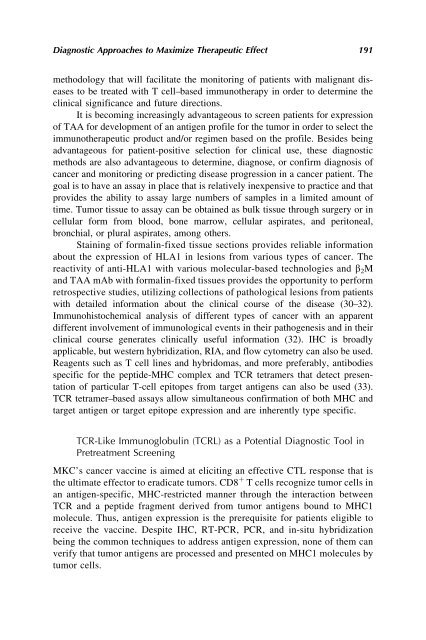Download File - JOHN J. HADDAD, Ph.D.
Download File - JOHN J. HADDAD, Ph.D.
Download File - JOHN J. HADDAD, Ph.D.
You also want an ePaper? Increase the reach of your titles
YUMPU automatically turns print PDFs into web optimized ePapers that Google loves.
Diagnostic Approaches to Maximize Therapeutic Effect 191<br />
methodology that will facilitate the monitoring of patients with malignant diseases<br />
to be treated with T cell–based immunotherapy in order to determine the<br />
clinical significance and future directions.<br />
It is becoming increasingly advantageous to screen patients for expression<br />
of TAA for development of an antigen profile for the tumor in order to select the<br />
immunotherapeutic product and/or regimen based on the profile. Besides being<br />
advantageous for patient-positive selection for clinical use, these diagnostic<br />
methods are also advantageous to determine, diagnose, or confirm diagnosis of<br />
cancer and monitoring or predicting disease progression in a cancer patient. The<br />
goal is to have an assay in place that is relatively inexpensive to practice and that<br />
provides the ability to assay large numbers of samples in a limited amount of<br />
time. Tumor tissue to assay can be obtained as bulk tissue through surgery or in<br />
cellular form from blood, bone marrow, cellular aspirates, and peritoneal,<br />
bronchial, or plural aspirates, among others.<br />
Staining of formalin-fixed tissue sections provides reliable information<br />
about the expression of HLA1 in lesions from various types of cancer. The<br />
reactivity of anti-HLA1 with various molecular-based technologies and b2M<br />
and TAA mAb with formalin-fixed tissues provides the opportunity to perform<br />
retrospective studies, utilizing collections of pathological lesions from patients<br />
with detailed information about the clinical course of the disease (30–32).<br />
Immunohistochemical analysis of different types of cancer with an apparent<br />
different involvement of immunological events in their pathogenesis and in their<br />
clinical course generates clinically useful information (32). IHC is broadly<br />
applicable, but western hybridization, RIA, and flow cytometry can also be used.<br />
Reagents such as T cell lines and hybridomas, and more preferably, antibodies<br />
specific for the peptide-MHC complex and TCR tetramers that detect presentation<br />
of particular T-cell epitopes from target antigens can also be used (33).<br />
TCR tetramer–based assays allow simultaneous confirmation of both MHC and<br />
target antigen or target epitope expression and are inherently type specific.<br />
TCR-Like Immunoglobulin (TCRL) as a Potential Diagnostic Tool in<br />
Pretreatment Screening<br />
MKC’s cancer vaccine is aimed at eliciting an effective CTL response that is<br />
the ultimate effector to eradicate tumors. CD8 þ T cells recognize tumor cells in<br />
an antigen-specific, MHC-restricted manner through the interaction between<br />
TCR and a peptide fragment derived from tumor antigens bound to MHC1<br />
molecule. Thus, antigen expression is the prerequisite for patients eligible to<br />
receive the vaccine. Despite IHC, RT-PCR, PCR, and in-situ hybridization<br />
being the common techniques to address antigen expression, none of them can<br />
verify that tumor antigens are processed and presented on MHC1 molecules by<br />
tumor cells.

















